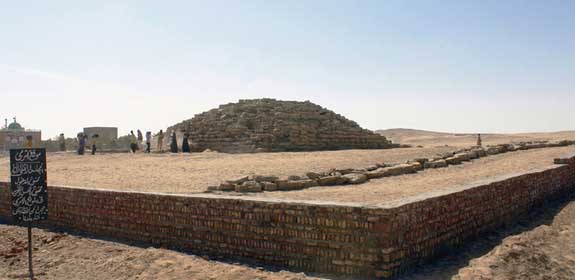
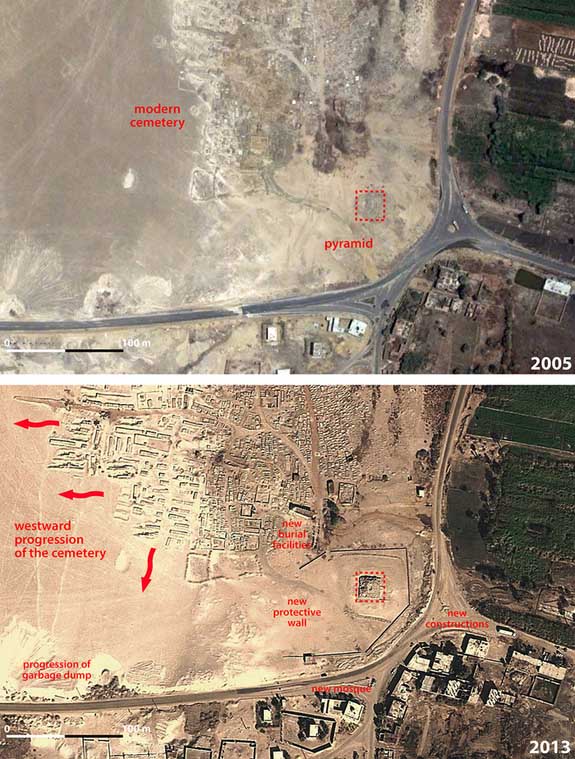
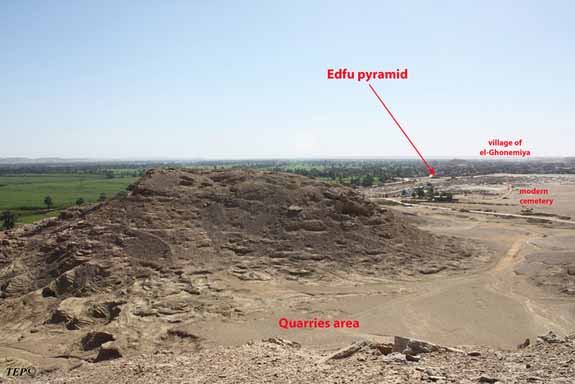
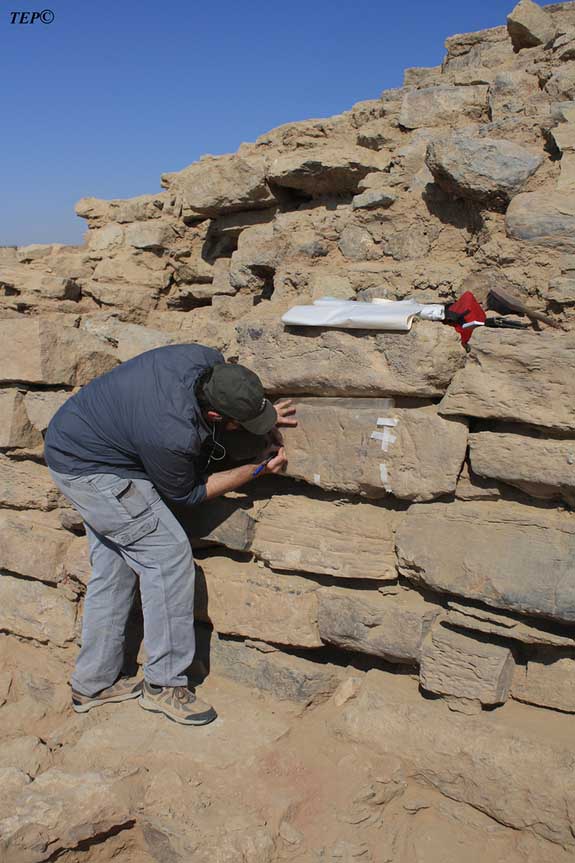
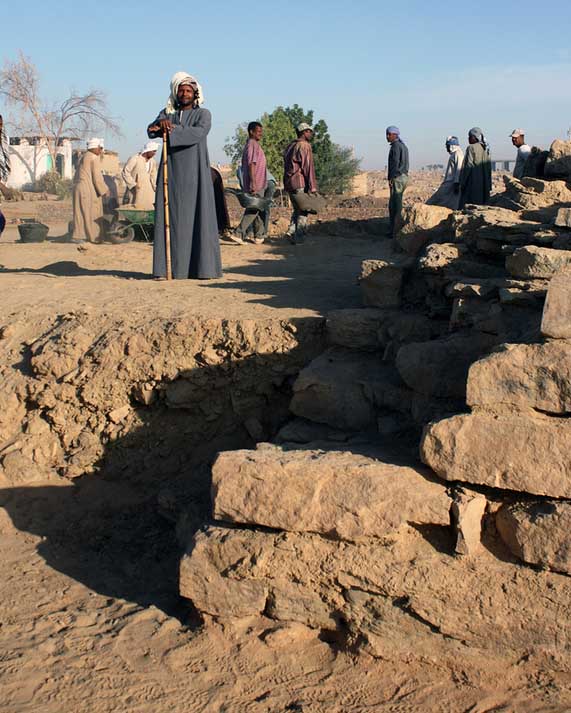
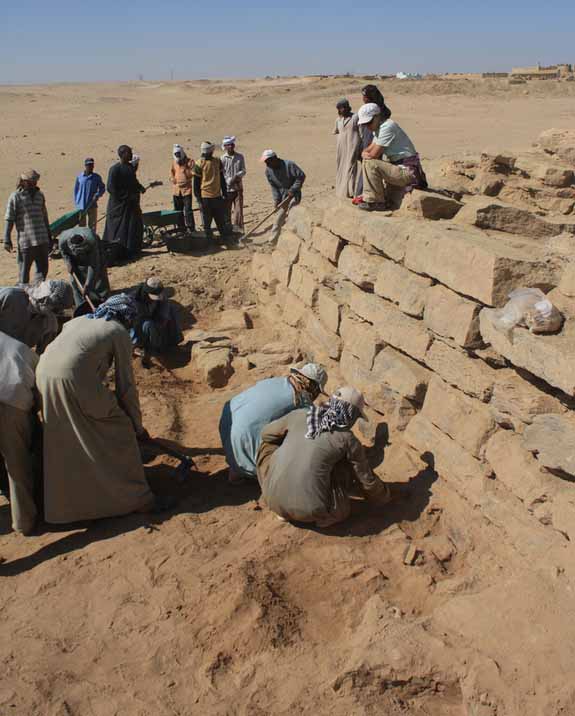
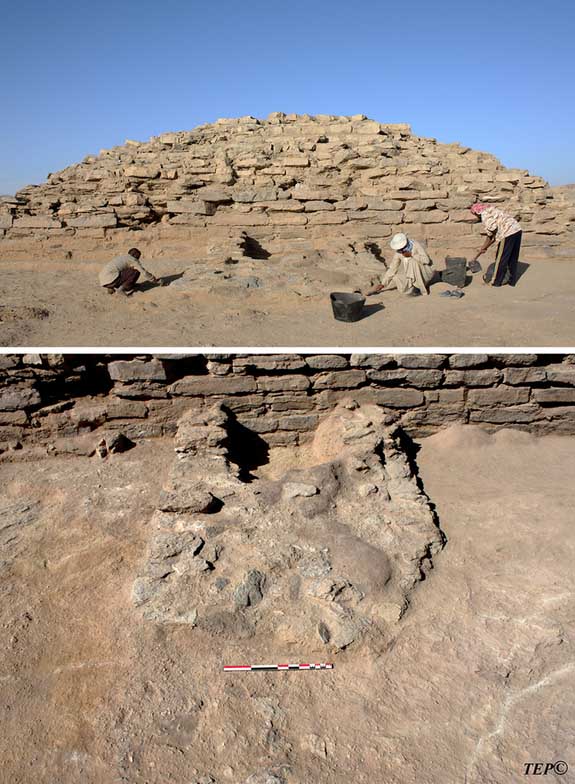
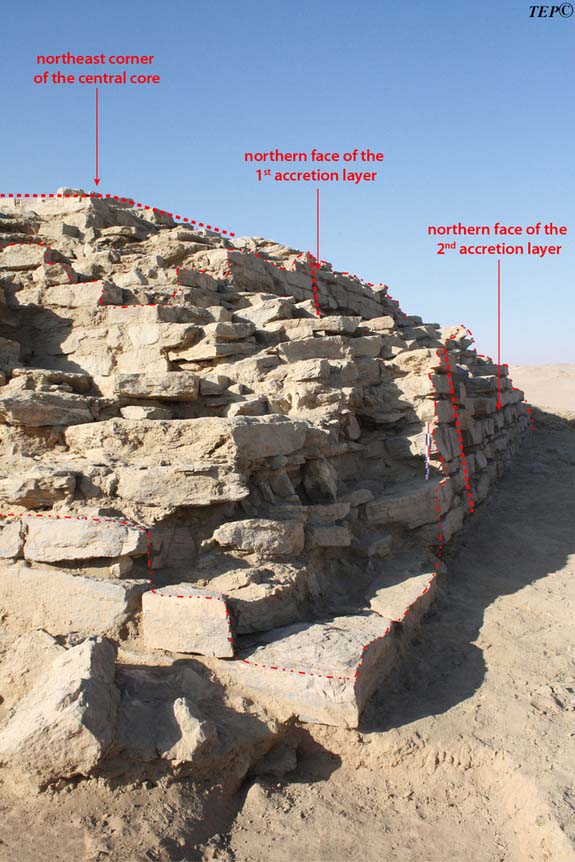








The Edfu South Pyramid is part of a group of seven very similar small step pyramids which were all built far from the main centres of Egypt and about which very little is known, along with the pyramids of Elephantine, el-Kula , Naqada, Saujet el-Meitin , Sinki and Seila. It is located about five kilometres south of Edfu near Naga el-Ghoneimeya. It was first identified as a pyramid in 1979, when the German archaeologists Günter Dreyer and Werner Kaiser were leading a survey of Edfu after a tip off from the inspector. Further investigation and surveys of the surrounding area have been undertaken since 2010 by the Oriental Institute of the University of Chicago.
According to the findings of Dreyer and Kaiser, the pyramid was 35-6 cubits long on each side (about 18.30-18.80 metres). It is now about 4.9 metres high. It consisted of a core structure measuring 8.3 metres on each side, surrounded by two courses of stone about four cubits thick. Dreyer and Kaiser suggested that the pyramid had had three steps. The angle of the slope cannot be accurately determined, but it was probably between 10° and 14°. The pyramid is almost oriented to the north, but is slightly off true north (like the other pyramids named above) as it is primarily oriented in order to be parallel to the Nile. The pyramid is built from local grey-blue and red sandstone. The individual blocks are only roughly hewn - on average they are 30 cm thick, but the largest examples measure 60-80 cm. A mixture of clay and sand was used as mortar.
The builder and purpose of the pyramid and unknown. Dreyer and Kaiser thought that it and the other pyramids named above were part of a single building project of Pharaoh Huni, the last ruler of the Third Dynasty. Andrzej Cwiek mostly agrees, but suggests that Huni's successor, Sneferu (c.2670-2630 BC) the founder of the Fourth Dynasty, was the builder. Speculation about the function of the pyramids ranges from a representation of the king, a depiction of the benben, or a symbol of the political and religious unity of the land to a cenotaph for a royal wife.
Though this pyramid's west side also runs parallel to the Nile River, it differs somewhat from the other small pyramids in being built from rough reddish sandstone. It is located near the village of Naga el-Goneima on the west bank of the Nile about five kilometers north of Edfu.
February 4, 2014 - Archaeologists Unearth 4,600-Year-Old Step Pyramid in Egypt -
The pyramid belongs to a series of almost identical small pyramids that have been discovered near several provincial centers in Egypt such as Elephantine, Hierakonpolis, Naqada, Abydos, Zawiet el-Meitin near Minya, and Seila in the Fayum.
According to an inscription found at Elephantine that can be linked directly to this pyramid, the whole group dates to the reign of Pharaoh Huni (around 2600 BC), last ruler of the 3rd Dynasty.
The monument is situated north of the modern village of al-Ghonemiya – between the edge of the desert and the cultivated areas of the Nile Valley, about 5 km south of Tell Edfu and at 25 km south of the pyramid of al-Kula, which is linked to the major Predynastic site of Hierakonpolis.
The first reference to the Edfu pyramid dates back to 1894, when G. Legrain indicated a ‘false’ pyramid at the entrance of the Edfu-Kharga caravan road. In 1908, H. de Morgan mentioned the structure again, and two years later Arthur Weigall mentioned its presence in his Guide to the Antiquities of Upper Egypt from Abydos to the Sudan Frontier.
In 2009, the archaeological team led by Dr Gregory Marouard from the University of Chicago’s Oriental Institute and Dr Hratch Papazian from the University of Copenhagen commissioned the Tell Edfu Project in order to unearth and protect this pyramid.
According to the archaeologists, the Edfu pyramid had been built directly on the sandstone bedrock and was made exclusively of sandstone and some calcareous sandstone blocks. The quarry area has been discovered only 800 m north of the site during an extensive preliminary survey conducted on some of the small hills that mark the desert edge at the site.
The construction itself reflects a certain care and a real expertise in the mastery of stone construction, especially for the adjustment of the most important blocks. The stones had been cut roughly into shape by percussion without any further refinement, but they are all relatively similar in size with standardized dimensions of 65-80 cm in length for the upper part. In the lower part, some blocks regularly exceed 1.0-1.5 m in length and more than 2 m for some large slabs of very hard brown sandstone, which was mainly used for the external courses and for producing a solid foundation layer. The blocks are held together by a large amount of clay mortar that contains a considerable amount of river sand.
The Edfu pyramid was originally made of three steps, two inclined layers leaning against a central core. Its internal structure and the use of the accretion layer technique can be easily seen on the northern and southern faces.
Along its base the pyramid measures about 18.5 m, which corresponds to about 35 royal cubits. The height reaches only 5 m today mainly because of the reuse of the blocks for private construction.
With a length of approximately 50 cubits in the diagonal direction through the center, a simple geometrical link between triangles can be used for evaluating the original elevation of the monument, which can be estimated to have been about 13 m (25 royal cubits). This means only less than a third of it remains today.
During 2009-2013 seasons, Dr Marouard and his colleagues have discovered two groups of post-Old Kingdom graffiti. Two graffiti on the north face and two graffiti on the south face incised on the soft and light-colored stone blocks. Both groups are located toward the center of each side, and they were at eye level in antiquity.
One of the blocks on the south side contains four signs: a four-legged animal, a seated man, a reed leaf, and a book roll; a fifth sign, a bird, is placed a few centimeters away to the right. The second block on the south side only has parallel lines or lines that make triangles.
On the north side, a block on the lower half shows a four-legged animal, which is not carved as nicely as the one of the south side. Another block above and to the right of this one shows a series of vertical lines, some of them double lines.”
This may indicate that the Edfu pyramid had kept its symbolic form and significance throughout a large part of the pharaonic period.
The archaeologists have recently unearthed the stone foundation of a small shrine or offering chapel near the monument.
It might have been used for the royal cult of the late Third Dynasty Pharaoh Huni, to whom this pyramid has been attributed.
4,600-Year-Old Step Pyramid Uncovered in Egypt Live Science - February 3, 2014
Archaeologists working near the ancient settlement of Edfu, in southern Egypt, have uncovered a step pyramid that dates back about 4,600 years, predating the Great Pyramid of Giza by at least a few decades. The step pyramid, which once stood as high as 43 feet (13 meters), is one of seven so-called "provincial" pyramids built by either the pharaoh Huni (reign ca. 2635-2610 B.C.) or Snefru (reign ca. 2610-2590 B.C.).
Over time, the step pyramid's stone blocks were pillaged, and the monument was exposed to weathering, so today, it's only about 16 feet (5 m) tall. Scattered throughout central and southern Egypt, the provincial pyramids are located near major settlements, have no internal chambers and were not intended for burial. Six of the seven pyramids have almost identical dimensions, including the newly uncovered one at Edfu, which is about 60 x 61 feet (18.4 x 18.6 m).
The purpose of these seven pyramids is a mystery. They may have been used as symbolic monuments dedicated to the royal cult that affirmed the power of the king in the southern provinces. "The similarities from one pyramid to the other are really amazing, and there is definitely a common plan," said Gregory Marouard, a research associate at the University of Chicago's Oriental Institute who led the work at the Edfu pyramid.
On the east side of the newly uncovered pyramid, his team found the remains of an installation where food offerings appear to have been made - a discovery that is important for understanding this kind of pyramid since it provides clues as to what they were used for.
The team also found hieroglyphic graffiti incised on the outer faces of the pyramid. The inscriptions are located beside the remains of babies and children who were buried at the foot of the pyramid. The researchers think the inscriptions and burials date to long after the pyramid was built and that the structure was not originally intended as a burial place. Initial results of the excavation were presented at a symposium held in Toronto recently by the Society for the Study of Egyptian Antiquities.
Uncovering the pyramid
Though scholars knew of the existence of the pyramid at Edfu, the structure had never been excavated before Marouard's team started work in 2010, he said in the study. His team found that the pyramid was covered by a thick layer of sand, modern waste and remains from the pillaging of its blocks.
It didn't look like a pyramid he said, and people in a nearby village even thought the structure was the tomb of a sheikh, a local Muslim saint. As the team went to work cleaning the monument, the ancient pyramid was revealed.
Built of sandstone blocks and clay mortar, it had been constructed in the form of a three-step pyramid. A core of blocks rises up vertically, with two layers of blocks beside it, on top of each other. This made the pyramid look like it had three steps.
The style is similar to that of a step pyramid built by Djoser (reign ca. 2670-2640 B.C.), the pharaoh who constructed Egypt's first pyramid at the beginning of the third ancient Egyptian dynasty. The technique is close to that used at the Meidum pyramid, which was built by either Snefru or Huni and started out as a step pyramid before being turned into a true pyramid.
"The construction itself reflects a certain care and a real expertise in the mastery of stone construction, especially for the adjustment of the most important blocks," said Marouard in his paper. Marouard also noted that the pyramid was built directly on the bedrock and was constructed entirely with local raw materials. The quarry where the sandstone was extracted was discovered in 2011, and is located only about a half mile (800 m) north of the pyramid.
The growth of a modern-day cemetery and village poses a danger to the newly uncovered pyramid. In order to help prevent further looting, a fence was built around the structure, thanks to financial assistance from the American Research Center in Egypt and the National Endowment for the Humanities.
Graffiti and child burials
As the team uncovered the pyramid, they found that inscriptions had been incised on its outer faces. They include hieroglyphic depictions of a book roll, a seated man, a four-legged animal, a reed leaf and a bird. "These are mostly private and rough inscriptions, and certainly dedicated to the child/babies' burials located right under these inscriptions at the foot of the pyramid," Marouard told Live Science in an email. One of the inscriptions appears to mean "head of the house" and may be a reference to the mother of a buried child. Marouard said his team would be publishing these burials and images in more detail in the future.
A pyramid abandoned
The archaeologists found that by the time of the reign of Khufu (the pharaoh who built the Great Pyramid), ca. 2590-2563 B.C., the pyramid at Edfu had been abandoned, and offerings were no longer being made. This occurred less than 50 years after its construction, Marouard said.
This suggests the seven small pyramids stopped being used when work on the Great Pyramid began. It seems Khufu no longer thought there was a need to maintain a small pyramid at Edfu, or elsewhere in southern Egypt, Marouard said. Rather, Khufu focused all the resources on building the Great Pyramid at Giza, which is close to the Egyptian capital at Memphis, he added.
Khufu may have felt politically secure in southern Egypt and saw no need to maintain or build pyramids there, Marouard said in the email. The "center of gravity of Egypt was then at Memphis for many centuries — this region draining resources and manpower from the provinces, all regions being put to use for the large construction sites of funerary complexes."
At Wadi al-Jarf, a port found on the shore of the Red Sea that dates to Khufu's time, papyri (written documents) dating to the end of Khufu's reign were recently discovered that supports the idea that the pharaoh tried to converge all the resources he could toward Giza and the ancient wonder being constructed there.